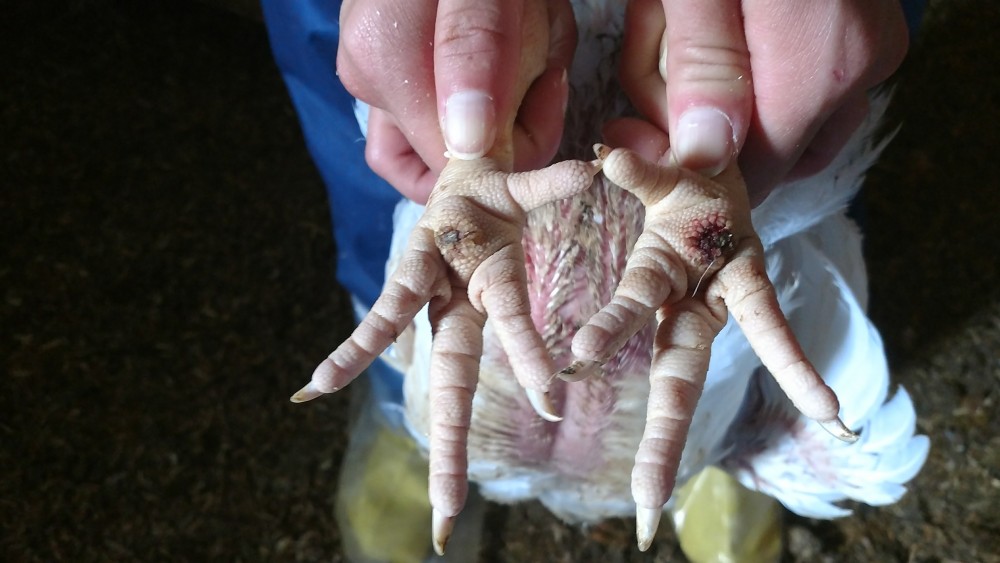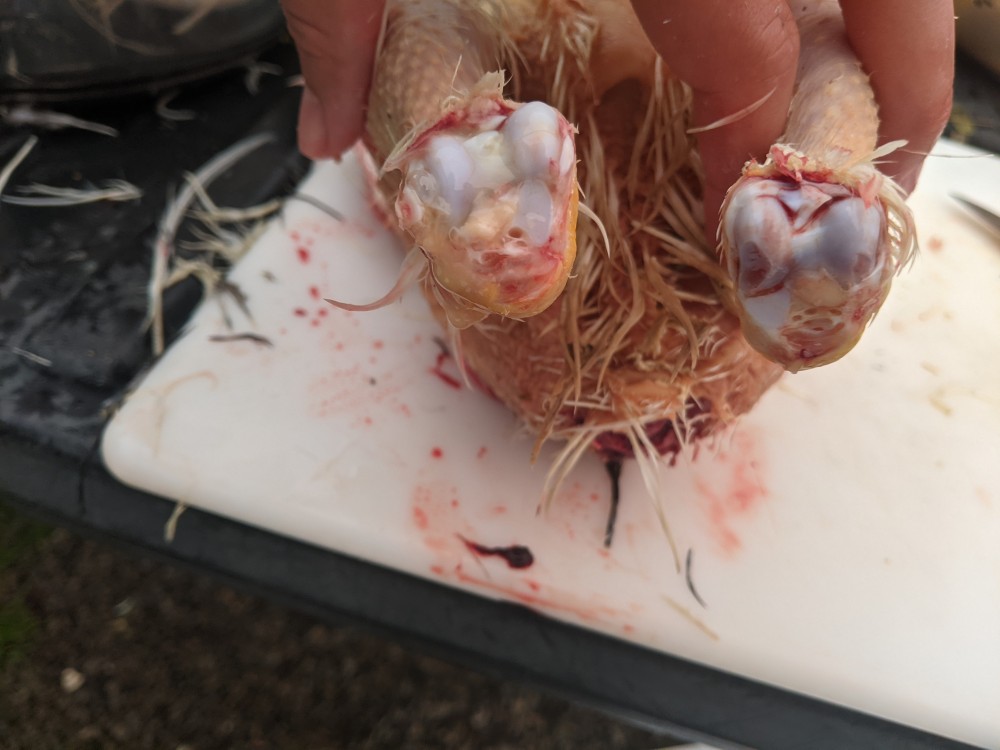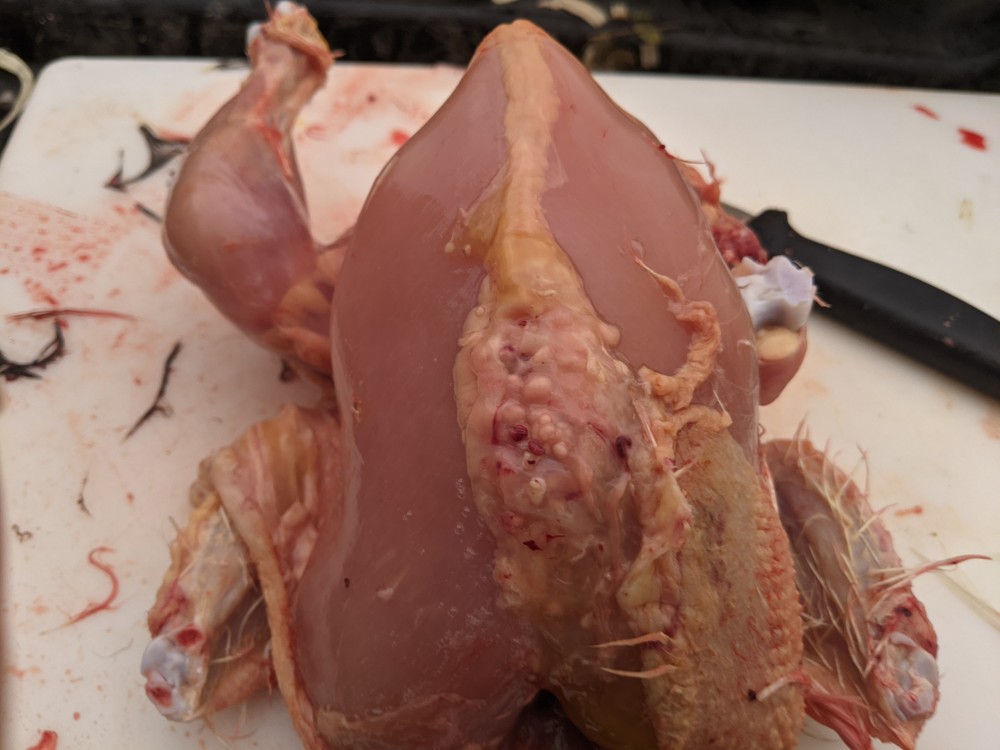Is it Safe to Eat? Inspecting Poultry for Wholesomeness During Processing
Amy Barkley, Livestock Specialist
Southwest New York Dairy, Livestock and Field Crops Program
Is it Safe to Eat? Inspecting Poultry for Wholesomeness During Processing
by Amy Barkley, Livestock Specialist SWNYDLFC
In NYS, we are lucky to have the capacity to process chickens under various inspections and exemptions. Those who take their poultry to be processed at a USDA or 5A facility have the expertise of the processors to remove and dispose of birds and parts that are not fit for sale. However, those of us processing under the 1,000 bird exemption may not be as familiar with the characteristics that indicate that a carcass that should be discarded instead of fed to our families or sold to customers. This article outlines some of the characteristics to identify during processing that render a whole meat bird or its parts unsalable. The reason behind this is to not allow potentially contaminated carcasses into the food system.
For a refresher on what normal poultry should look like, check out this University of Kentucky fact sheet: http://www2.ca.uky.edu/agcomm/pubs/ASC/ASC210/ASC210.pdf
There are two types of inspections that we should be doing to all live poultry that is destined for processing. The first is anti-mortem, meaning "before death", inspection. Birds fit for processing should be bright, alert, and responsive. They shouldn't show signs of illness and should be able to stand on their own. Birds that have unusual swellings, deep cuts, infections, or distended abdomens are not fit for processing. Other abnormalities listed by the USDA include swelling around the head and eyes, swollen wattles, gasping/sneezing, off-colored faces, diarrhea, skin lesions, and wry necks. These birds should be set aside and processed last, or if they are sick should be treated and allowed to recover before processing or euthanized and either composted, buried, or rendered.
Post-mortem processing inspections follow the killing the bird. Some of the defects can be seen on the outside of the carcass, others are not observed until the bird is eviscerated.
If identified, these abnormalities can be either left if they meet the definitions below or trimmed out and the remainder of the carcass be utilized:
- Breast Blisters are inflammatory, fibrous, fluid-filled, or pus-filled tissues that are identified along the breastbone. If the nodule or affected area is larger than the size of a dime, it needs to be cut out. If the tissue is pus-filled, it needs to be removed regardless of size. Many times these inflamed or fibrous tissues can adhere to the breast bone.
- Bruises that are red or pink in color have usually occurred within 12-24 hours of processing and can be left on the carcass if they are between ½" - 1" in diameter and there are no more than five of them on the carcass. If the bruises are larger than an inch, then only 3 can be left on the carcass.
- Bruises that are green or black are aged bruises that happened several days to a week or two before processing. If they are between ¼" - 1" in diameter, three are allowed on the carcass. If they are larger than 1", then only two are allowed. Most people find these unsetting and cut them out regardless of size.
- Internal organs with lesions should not be saved for consumption. This includes any pus, tumors, or miscolored organs. If the entire body cavity is filled with tumors or pus, that whole bird should be discarded.
- Parts with fractured bones are OK to consume but are typically trimmed off for aesthetic purposes.
- Sores, scabs, or inflammatory processes that are smaller than ½" can be left on the carcass if there are two or fewer. If those lesions are larger than ½" or there is a cluster of lesions smaller than ½", then only one can be left on the carcass. If an organ or joint is compromised, then it can be removed and the rest of the carcass can be consumed.
- Parasites can sometimes affect chickens. If an organ or other part of the carcass is infested with parasites, that part of the bird needs to be condemned. If systemic, the whole carcass needs to be condemned.
If identified, these conditions require that the entire carcass be condemned.
- Diseases of the leukosis complex can result in tumors within the body cavity. Many times, these are attached to organs. If the tumors are isolated to one organ or tissue, that tissue or organ can be removed and the rest of the bird used. If it is systemic where there are many organs or tissues are affected, the whole bird will need to be removed from the food supply.
- Blood-borne bacterial infections like septicemia can cause the following abnormalities: pinpoint hemorrhages on the heart, liver, kidneys, muscles, and membranes. The liver, spleen, and kidneys can be swollen. The whole carcass may show multiple small hemorrhages (bruises) across the body.
- Airsacculitis is a bacterial infection of the air sacs within the body of the chicken. The air sacs are thin membranes within the body cavity. A bird with this condition will have cheesy or stringy-looking globs or strands on these otherwise thin, clear membranes.
- Whole-body parasite infestation, whether current or previously infected.
A good rule of thumb to remember is that if something on a poultry carcass doesn't look normal, it shouldn't enter the food supply.
For more detailed reading, visit: https://www.govinfo.gov/content/pkg/CFR-2018-title9-vol2/pdf/CFR-2018-title9-vol2-part381-subpartK.pdf
For questions on this article or poultry processing in general, you can reach out to Amy at 716-640-0844 or amb544@cornell.edu.
The photos below are of three common issues that we see in broiler chickens: footpad lesions, hock swelling, and breast blisters. Click on any image below to enlarge it.

This photo illustrates footpad lesions on an anti-mortem inspection. The foot on the left looks like the skin damage is only on the outermost layer, so it will likely peel in the plucker, but the foot on the right has an injury that goes deep into the flesh. This foot would be condemned post-mortem. Photo by Amy Barkley.

This photo shows an infected hock joint on a broiler chicken. The joint in the left side of the image shows swelling. When live, this bird had trouble walking and the affected joint was visibly enlarged and felt liquid-filled. Post-mortem, the joint was cut open to reveal swollen internal structures filled with pus and excessive clear fluid. This drumstick and foot were condemned. Photo by Amy Barkley.

This photo illustrates two defects on a broiler chicken. Along the breast bone is a breast blister. On the anti-mortem inspection, this presented as hardened skin that moved like there was jelly underneath when manipulated. This is what it looked like post-mortem when the skin was removed. Because of it's extensive nature, the chicken was deboned. The second defect is in the leg on the right side of the image. It had pus in the hock joint, so the drumstick and foot were condemned. No inflammatory process or pus was found in the thigh joint. This is a common result of birds going down in the legs. The excess pressure applied to the hocks and breast often result in these two conditions. Photo by Amy Barkley.
Upcoming Events
WEBINAR - Automated Milking Systems Efficiency: Balancing Focus on Individual Cows and System Optimization
May 8, 2024
Please join Cornell the SWNY team and MSU Extension for our talk with Dr. Pablo Silva Boloña on improving efficiency of Automated milking systems by focusing on milking settings for individual and group success.
Broiler Field Day at Sunny Cove Farm
June 6, 2024
Alfred Station, NY
Join us for a field day to explore broiler production, processing, and finances. Meghan Snyder of Sunny Cove Farm will be our host. She raises small batches of organic broilers, processing them on-farm under the 1,000 bird exemption.
Stockmanship and Stewardship 2024
October 25, 2024
Hamburg, NY
Save the date!! The event is one of 4 across the US and is a two-day educational experience featuring low-stress cattle handling demonstrations, Beef Quality Assurance educational sessions, facility design sessions, and industry updates.
Announcements
No announcements at this time.





